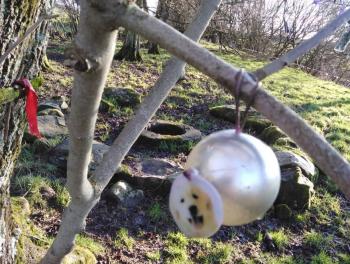Holy or sacred wells, historic springs and related 'watery sites' are places in the landscape where 'knowledge and practices concerning nature and the universe' are enacted. These sites continue to be visited in Scotland for a variety of reasons; sometimes waters are perceived to have healing power or health-bestowing properties; sometimes the places themselves are thought to be efficacious because of their natural beauty, historical or spiritual significance. Holy wells are also entwined in other traditions such as pilgrimage, healing/plant/herb lore, weather traditions, storytelling/music, placenames/language and so on.
The term 'holy well' covers a variety of sites. Springs are places where groundwater issues at the earth’s surface, and a ‘holy well’ is most commonly a sacred spring, or any natural source of fresh water that is rooted in Christian ritual practice. A ’holy well’ is sometimes a spring that flows into a manufactured basin or receptacle, over which a well-house or structure has been built. But 'holy wells' can also be rock crevices, natural basins, seepage pools, cavities in trees where dew/rain/sea water collects. Sixth century CE stories relating to Saint Columba indicate that wells or springs were venerated prior to the arrival of Christianity, and it is becoming clear from recent archaeological work that Pictish sites in both the north and south of Scotland had wells or rock cut basins that were probably set aside for ceremonial or ritual use. The water at holy wells is sometimes seen as important – i.e., that it contains healing properties or that is good/healthful to drink or bathe in. Some wells might have a high quality of water as a result of geological conditions that enrich the water with minerals, but often wells and their water are considered efficacious due to the sacred traditions and folklore concerning the origins of the well or spring itself. In terms of their intangible cultural heritage, the key feature of a 'holy well' is the knowledge and practices concerning nature and the universe that gives them meaning in the contemporary world.
Today, the communities and individuals who use these sites might do so for a variety of reasons. For some, they are sites of ‘liminality’, where the veil between the spiritual/physical world is thin; some see them as sites where troubles, illnesses or unwanted (psychological/physiological) burdens can be left; related to this also is their historic role as a site of pilgrimage, whether to venerate a saint, a 'genius loci' or spirit of place, or some other form of spiritual being. Offerings or ‘leavings’ at wells is also an important practice. The leaving of ‘clooties’ (‘Clootie Wells’ have a separate entry on this database https://ichscotland.org/wiki/clootie-cloutie-wells) sit alongside other practices, such as the leaving of tokens, remembrances, ‘dreams’ or wishes. These might take a variety of forms - locks of hair of a loved one, children’s toys, pictures of pets, coins, ‘spirit-bottles’ and other contemporary items – the meanings of such things often reside in the intentions of the giver and cannot be easily understood. During the covid-19 pandemic of 2019-2022, it was reported that face-masks were left at St. Queran’s Well in Dumfriesshire - it is likely that there were/are regional variations. Again, this may relate to the long-established belief of ‘transference’; i.e., that a malady can be transferred to an item if left at an efficacious place such as a cross-roads or holy well. Because holy wells are often in remote places and yet on well-trodden paths, they may become sites for recreation and youth culture; many historic examples exist of holy wells being sites of ‘trysts’, parties or social gatherings. Also, some sites appear to be the focus of digital culture – ‘Geocaching’ for example, in which participants use a GPS receiver or mobile device and other navigational techniques to hide and seek containers – are sometimes found at holy wells.
Holy wells and their related practices and beliefs permeate into other cultural forms (and the Five Domains of Intangible Cultural Heritage), such as Oral Traditions and Performing Arts. Story traditions may be found here https://www.tobarandualchais.co.uk/track/65649?l=en.
The safeguarding of wells is largely carried out by local communities who care for the physical sites and maintain their intangible traditions. For example, there are many Facebook ‘Friends Of…’ groups run by local guardians of wells (see the Muntlochy Clootie Well https://www.facebook.com/groups/clootiewell/ and the Green Well of Scotland https://www.facebook.com/groups/307155657152084/). The Woven Land Network also offers support to local people who wish to become ‘site monitors’ or ‘custodians’ of holy wells (and other sites); more details can be found here: https://cailleachs-herbarium.com/2022/07/custodian-monitors-members-and-...
Holy wells are avidly researched and visited all over Scotland and there is a significant amount of mapping information and interpretation of these sites available online. Various projects have attempted to map wells nationally or regionally across Scotland, notably The Megalithic Portal (www.megalithicportal.co.uk); Canmore (https://canmore.org.uk/), HolyandHealingWells (https://insearchofholywellsandhealingsprings.com/category/scotland/), and the Lost Wells of Galloway Project (https://gallowayglens.org/exploring-the-lost-wells-of-galloway/ - see also https://gallowayglens.org/wp-content/uploads/2022/03/Lost-Wells-of-Gallo...).

